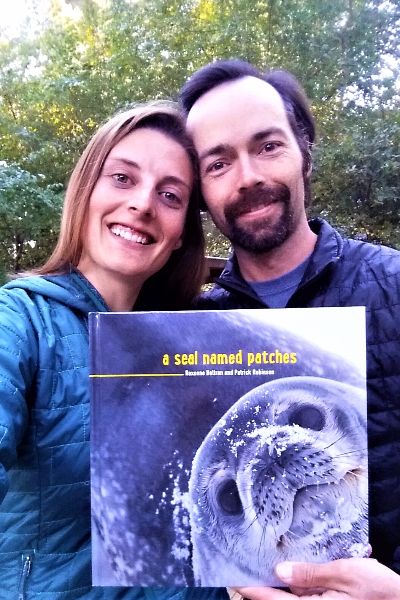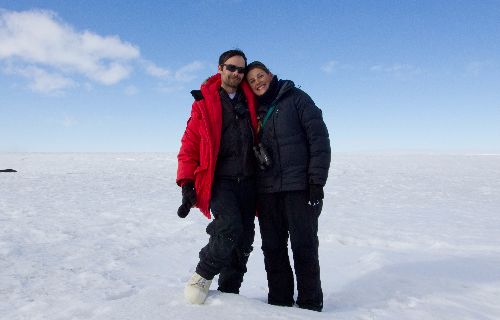As field scientists in Antarctica, Roxanne Beltran and Patrick Robinson have enough stories to fill a book.
There was the time they were standing a few feet from a watery channel in the ice when a minke whale suddenly let out an explosive exhale right next to them. Then there was the trip where Beltran and five of her colleagues were stranded for 33 hours in a remote hut the size of two minivans while a fierce storm raged around them. And then there were the beautiful, but sometimes treacherous, snow-machine rides from McMurdo Station to find the Weddell seals they were studying.
So, when a third-grader at an Alaskan elementary school where Beltran was speaking asked the scientist if she would write a book about her work so that the child’s father could read it to her every night, Beltran said, “Why not?”
The result is a new, 48-page children’s book published by the University of Alaska Press titled A Seal Named Patches, which sold out half its 2,000-volume printing within two weeks of its release. On November 29, it was announced as the 2017 winner of the DeBrary Outstanding Science Children's Book award.
“This book probably has more impact than any individual scientific paper we’ve written in terms of sheer readership and impact on readers,” said Robinson, director of the UC Natural Reserve at Año Nuevo, as he sat in a small trailer office across from Beltran, who is a visiting researcher at UC Santa Cruz and a Ph.D. candidate at the University of Alaska, Fairbanks. Beltran’s research is funded by the National Science Foundation under the direction of principal investigator Jenn Burns.
Having readers excitedly come up and ask them to sign their work, “is something you don’t really experience in science,” Robinson added.
The idea of scientists being autograph-worthy made the two researchers grin.
Both UC Santa Cruz alumni—she graduated from Stevenson College in 2013 with a degree in marine biology and he graduated with the same degree from Rachel Carson College in 2003—the two are engaged to be married and have each taken seven trips to Antarctica, although only twice have they been there at the same time.
For them, Antarctica is a place of unparalleled beauty and discovery, and the Weddell seals are fascinating creatures.
The seals, which weigh about 1,000 pounds, can hold their breath for up to 90 minutes and make dives as deep as 3,000 feet underwater. They are the world’s southernmost breeding mammal and, unlike other species, live in Antarctica year round, using their sharp teeth to maintain air holes in the ice.
“They are also one of the most docile seal species on the planet,” Robinson said. “They don’t have land predators so they don’t see humans as a threat. You can just walk up to them.”
“A lot of them, when you walk close, will roll on their backs to look at you,” Beltran added.
It was that kind of first-hand experience, along with the uniqueness of Antarctica, that prompted Beltran to cofound a program with another grad student to bring their research to some 4,000 Alaskan students from kindergarten through grade 12, which was how the book request came about.
“I came home and Skyped Patrick and said, ‘We have to write a book.’” Beltran remembered. “I thought he would tell me I was crazy. He said, ‘Sure. How can I help?’”
Full of photographs, many taken by the pair, the tale centers on scientists’ hunt for a seal named Patches that had been tracked since birth but seemed to have disappeared. Patches, said Beltran, is based on two real-life seals: Very Old Mom and Little Red.
Very Old Mom was 30 years old and had given birth to 21 pups. Little Red was one of the smallest seals they saw and was the model for a fabric seal Beltran crafted for her talks that carried patches signed by all the students from the schools she and her cofounder visited.
Endorsed by people like famed primatologist Jane Goodall and National Geographic photographer Paul Nicklen, the book ends with the happy scientific team discovering Patches and her newest pup, the sign of a good year for the Weddell seals.
Beltran and Robinson said they’re considering another book designed to inspire young field scientists based on an elephant seal named Phyllis who swam nearly 7,400 miles on her annual migration, longer than any elephant seal recorded by UC Santa Cruz Professor Dan Costa’s research team in the last two decades.
“I tell kids that we’re all scientists,” Beltran said. “If you ask questions and try to find answers using the scientific method, then you are just as much a scientist as the rest of us.”
A Seal Named Patches is available at the Seymour Marine Discovery Center in Santa Cruz, the Monterey Bay Aquarium, Amazon, Target, and Walmart.





